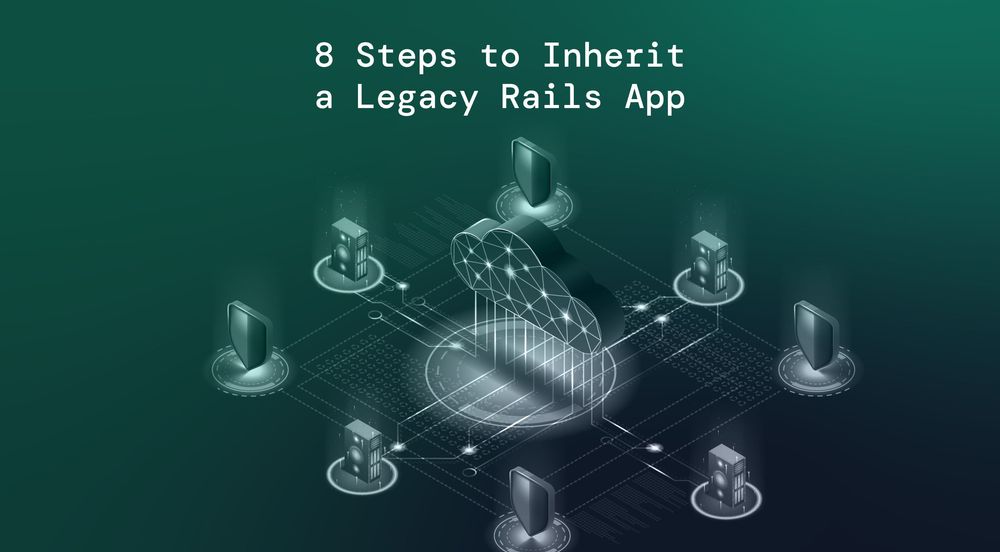Over two-thirds of businesses still rely on legacy applications for core operations, and over 60% use them for customer-facing functions, according to a study by TCS and AWS. Yet, these legacy systems come with major challenges—61% struggle with integration, 57% face agility issues, and 55% cite security risks.
So, if you’ve inherited a legacy Ruby on Rails application, chances are you’re dealing with similar hurdles.
Maybe you’re joining a new company, taking over a client project, or just got assigned to an old system that’s been running for years. Whatever the case, working with a legacy Rails app can feel overwhelming. Outdated dependencies, security vulnerabilities, and a lack of documentation can make even experienced developers sweat.
But don’t worry—you don’t have to untangle this mess blindly. With a structured approach or with the help of Rails upgrade services, you can regain control, upgrade the Rails version, and get the app running smoothly on the latest version of Ruby on Rails.
1. Understand the Business Logic and Application Goals
Before you dive into the code, take a step back and understand the purpose of the application.
- What problems does it solve?
- Who are its users?
- What features are business-critical?
This insight will help you prioritize fixes and improvements without unintentionally breaking key functionality.
2. Understand the Codebase Before Making Changes
Before you touch a single line of code, take the time to understand what you’re working with. Legacy apps often come with undocumented features, outdated dependencies, and unconventional architecture. Here’s how to get started:
Dive into the Documentation (If It Exists)
Check if there’s any documentation—README files, wikis, or even comments in the code. If documentation is sparse, don’t panic. You can still piece together the app’s functionality by exploring its structure.
Map Out the Architecture
Take stock of the app’s components: models, controllers, views, jobs, and services. Identify patterns and anti-patterns. For example:
- Are there fat controllers or bloated models?
- Is the app using service objects or plain old Ruby classes for business logic?
Understanding these patterns will give you a clearer picture of where potential issues might lie.
Explore Dependencies
Run bundle list to see which gems are in use. Pay special attention to older gems, as they may no longer be maintained or compatible with newer versions of Rails. This is where gems compatibility checker tool like RailsUp can shine. By analyzing your Gemfile, RailsUp helps you identify problematic dependencies early in the process, making your Rails upgrade process much smoother.
3. Set Up a Local Development Environment
A functional local environment is non-negotiable. Without it, debugging and testing becomes nearly impossible. Follow these steps to get set up:
Install Required Tools
Ensure you have the correct Ruby version, database, and other dependencies installed. Use tools like rbenv or rvm to manage Ruby versions easily.
Run the Test Suite
If the app has tests, run them to gauge the current state of the codebase. If tests fail, investigate why—they could reveal underlying issues. If there are no tests, consider writing some basic ones to cover critical functionality before making changes.
Check for Missing Features
Sometimes, legacy apps rely on external APIs or third-party services that may have changed over time. Verify that all integrations are still functional.
4. Assess the App’s Health
Once your environment is ready, it’s time to evaluate the app’s overall health. Think of this step as a doctor diagnosing a patient before prescribing treatment.
Audit Security Vulnerabilities
Use tools like RailsUp to scan for known vulnerabilities in your gems. Addressing security issues should be a top priority, especially if the app handles sensitive data.
Analyze Performance Bottlenecks
Legacy apps often suffer from performance issues due to inefficient queries or outdated practices. Tools like New Relic or Skylight can help pinpoint slow endpoints or database queries.
Review Code Quality
You can use static analysis tools to highlight areas of the codebase that need improvement. While fixing every issue isn’t feasible, addressing high-priority problems can make future development easier.
5. Plan for a Rails Upgrade
If the app is running on an older version of Rails like 6 or 7 or 7.2, upgrading from 7.2 to Rails 8 should be part of your long-term strategy. However, rushing into an upgrade without proper planning can lead to disaster. Here’s how to prepare:
Create a Roadmap
Break the upgrade process into manageable phases. For example:
- Update to the next minor version.
- Address deprecation warnings.
- Gradually move toward the latest version of Ruby on Rails.
Each phase allows you to test and stabilize the app before proceeding further.
Leverage RailsUp’s Gems Compatibility Checker
One of the biggest hurdles during a Rails upgrade is ensuring gem compatibility. RailsUp’s compatibility checker simplifies this process by analyzing your Gemfile and providing actionable insights. It tells you which gems are safe to use, which need updates, and which are incompatible. This tool is invaluable for creating a seamless Rails upgrade process tailored to your app.
Test Thoroughly After Each Step
After each incremental upgrade, run your test suite and manually test key features. Automated tests alone won’t catch everything, so hands-on testing is crucial. You can use modern testing approaches like shift left and shift right testing.
6. Refactor Strategically
Refactoring a legacy app requires balance. On one hand, you want to improve the codebase; on the other, you don’t want to introduce new bugs or disrupt existing functionality. Here’s how to refactor wisely:
Focus on High-Impact Areas
Prioritize refactoring parts of the codebase that are frequently modified or prone to errors. For instance, if certain models are tightly coupled, consider introducing service objects to decouple logic.
Adopt Modern Best Practices
Legacy apps often lack adherence to modern Rails conventions. Introduce improvements gradually:
- Replace callbacks with explicit methods where possible.
- Use Active Record enums instead of hardcoded strings.
- Implement background jobs for long-running tasks.
7. Implement Continuous Integration & Deployment
If CI/CD isn't already in place, consider setting up tools. By automating testing, every code change is validated before merging, catching bugs early and maintaining code quality.
A well-configured CI/CD pipeline runs tests, enforces coding standards, and automates deployments, allowing for faster, error-free releases. Additionally, monitoring and rollback mechanisms help detect and revert problematic updates, ensuring a smooth and reliable upgrade process.
8. Document Everything
Legacy apps often suffer from a lack of documentation. As you work on the app, take the time to document:
- Key workflows: How do the main features of the app work? What are the critical paths?
- Dependencies: Document any third-party services, APIs, or gems the app relies on.
- Decisions: Why was a particular approach taken? What trade-offs were made?
Good documentation will make it easier for future developers (or future you) to understand and maintain the app.
Final Thoughts
Inheriting a legacy Rails app is a mix of challenge and opportunity. By understanding the codebase, addressing technical debt, and planning a thoughtful Rails upgrade, you can transform chaos into clarity.
Tools like RailsUp’s gems compatibility checker and a solid Rails upgrade guide make the process smoother, helping you modernize with confidence.
Remember, progress—not perfection—is the goal. With patience and persistence, you’ll not only improve the app but can also turn your legacy Rails app into a maintainable and modern system.
Ready to modernize your legacy Rails app? Or struggling with a legacy Rails app? Turn your legacy Rails app into a future-ready system with our proven expertise in modernization. Discover how we can transform your Rails app.


